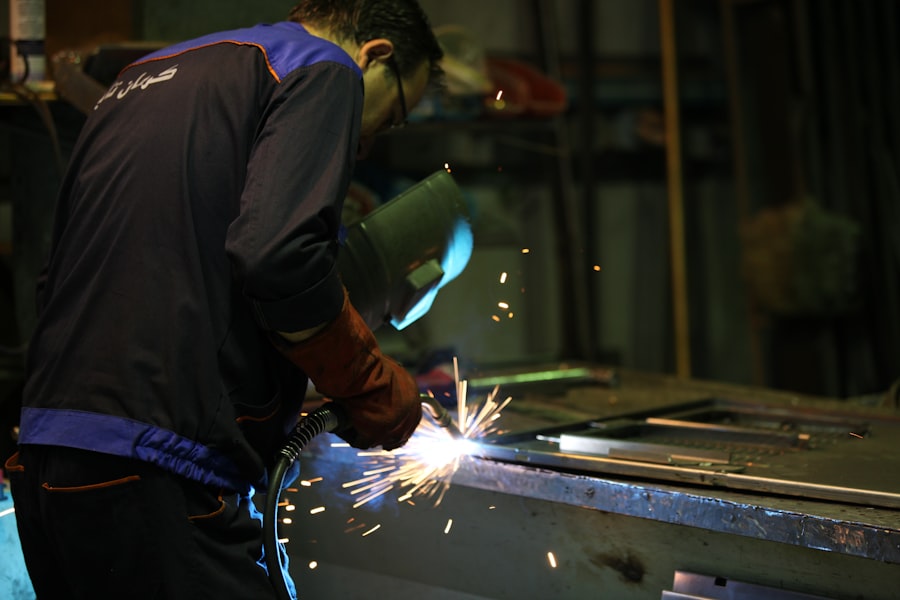Laser hair removal is a popular cosmetic procedure that utilizes concentrated beams of light to target and eliminate unwanted hair. If you’re considering this treatment for your facial hair, it’s essential to understand how it works. The laser emits a specific wavelength of light that is absorbed by the pigment in the hair follicles.
This process damages the follicles, inhibiting future hair growth while leaving the surrounding skin unharmed. The procedure is generally quick, often taking only a few minutes for small areas like the upper lip or chin. Before undergoing laser hair removal, you should be aware of the different types of lasers used in the process.
Some lasers are more effective on certain skin types and hair colors than others. For instance, darker hair typically responds better to laser treatment than lighter hair due to the contrast in pigmentation. Additionally, your skin type can influence the choice of laser; some lasers are designed specifically for lighter skin, while others are more suitable for darker complexions.
Understanding these basics will help you make informed decisions about your treatment options.
Key Takeaways
- Laser hair removal on the face targets hair follicles with concentrated light to inhibit future hair growth.
- Potential risks of overdoing laser hair removal on the face include burns, skin discoloration, and scarring.
- Frequency guidelines for laser hair removal on the face typically recommend treatments spaced 4-6 weeks apart.
- Signs of overdoing laser hair removal on the face may include excessive redness, swelling, and skin sensitivity.
- After laser hair removal on the face, it’s important to protect the skin with sunscreen, avoid hot showers, and moisturize regularly.
Potential Risks and Side Effects of Overdoing Laser Hair Removal
Skin Irritation and Reaction
One of the most common issues is skin irritation, which may manifest as redness, swelling, or a burning sensation in the treated area. If you undergo treatments too frequently or without proper intervals, your skin may not have enough time to heal, exacerbating these symptoms.
Blistering, Scabbing, and Scarring
In some cases, you might even experience blistering or scabbing, which can lead to scarring if not managed properly. This is a more severe consequence of excessive laser hair removal and should be taken seriously.
Pigmentation Changes
Another potential risk of excessive laser hair removal is hyperpigmentation or hypopigmentation. This occurs when the skin either darkens or lightens in response to the treatment, often as a result of inflammation or damage to the skin’s surface. These changes can be particularly concerning for individuals with darker skin tones, as they may be more susceptible to such side effects.
It’s crucial to recognize that while laser hair removal can be an effective solution for unwanted facial hair, moderation is key to avoiding these adverse effects.
Frequency Guidelines for Laser Hair Removal on the Face
Determining how often you should undergo laser hair removal on your face is essential for achieving optimal results while minimizing risks. Generally, most practitioners recommend spacing treatments about four to six weeks apart. This interval allows your skin to recover and ensures that the laser targets hair in its active growth phase, known as the anagen phase.
Since not all hair follicles grow at the same rate, adhering to this schedule can enhance the effectiveness of your treatments. However, individual factors such as hair growth cycles and skin sensitivity can influence how frequently you should schedule your sessions. For instance, if you notice that your hair grows back more slowly after a few treatments, you might be able to extend the time between sessions.
Conversely, if you have particularly fast-growing hair, you may need to stick closer to the recommended frequency. Consulting with a qualified professional can help you tailor a treatment plan that suits your specific needs and goals.
Signs That You May Be Overdoing Laser Hair Removal on Your Face
| Signs of Overdoing Laser Hair Removal on Your Face |
|---|
| 1. Excessive redness and irritation |
| 2. Swelling or puffiness |
| 3. Skin discoloration or changes in pigmentation |
| 4. Blisters or burns on the skin |
| 5. Increased sensitivity or pain during treatment |
| 6. Persistent itching or discomfort |
| 7. Unusual scarring or skin texture changes |
Recognizing when you might be overdoing laser hair removal is crucial for maintaining healthy skin and achieving desired results. One of the first signs to watch for is persistent redness or swelling that doesn’t subside within a few hours after treatment. While some temporary irritation is normal, prolonged symptoms may indicate that your skin is not recovering adequately between sessions.
If you find yourself experiencing discomfort that lingers or worsens over time, it may be time to reassess your treatment frequency. Another indicator that you might be overdoing it is the appearance of changes in your skin tone, such as dark or light patches where the laser has been applied. These changes can be a sign of hyperpigmentation or hypopigmentation and may require additional treatments or time to resolve.
If you notice any unusual skin reactions or if your facial hair seems to be growing back thicker or coarser after multiple sessions, it’s essential to consult with a professional who can evaluate your situation and recommend adjustments to your treatment plan.
How to Care for Your Skin After Laser Hair Removal
Post-treatment care is vital for ensuring that your skin heals properly after laser hair removal. Immediately following the procedure, it’s common for your skin to feel sensitive and appear slightly red. To soothe this irritation, applying a cool compress can provide relief and help reduce inflammation.
Additionally, using gentle skincare products that are free from harsh chemicals or fragrances will minimize the risk of further irritation. Hydration is also key in post-laser care. Keeping your skin moisturized helps support its healing process and can prevent dryness or flakiness that may occur after treatment.
Look for soothing creams or gels containing ingredients like aloe vera or hyaluronic acid, which can provide hydration without causing irritation. Furthermore, it’s crucial to protect your skin from sun exposure during the healing phase; wearing broad-spectrum sunscreen with an SPF of 30 or higher will help prevent pigmentation issues and safeguard your skin from UV damage.
Alternatives to Overdoing Laser Hair Removal on the Face

Electrolysis: A Permanent Solution
One popular option is electrolysis, which involves using an electric current to destroy individual hair follicles. This method is effective for all hair colors and skin types and can provide permanent results over time.
Waxing and Threading: Temporary Solutions
Another alternative is waxing or threading, both of which offer temporary solutions for facial hair removal. Waxing removes hair from the root and can last several weeks before regrowth occurs, while threading uses a twisted thread to pull hairs out from their follicles.
Comparing Methods: Invasiveness and Maintenance
These methods are less invasive than laser treatments and can be performed at home or in a salon setting.
Consulting with a Professional Before Undergoing Laser Hair Removal
Before embarking on your laser hair removal journey, consulting with a qualified professional is essential for ensuring safe and effective treatment. A licensed practitioner will assess your skin type, hair color, and medical history to determine whether you are a suitable candidate for the procedure. They will also discuss your goals and expectations, helping you set realistic outcomes based on your unique circumstances.
During this consultation, it’s important to ask questions about the technology used in their practice and their experience with laser hair removal. Understanding the type of lasers they employ and their approach to patient care will give you confidence in their expertise. Additionally, discussing any concerns about potential side effects or risks will help you make an informed decision about whether this treatment aligns with your needs.
Finding the Right Balance for Laser Hair Removal on the Face
In conclusion, achieving the right balance in laser hair removal on your face is crucial for both effective results and maintaining healthy skin. While this procedure offers a long-term solution for unwanted facial hair, it’s essential to approach it with caution and mindfulness regarding frequency and aftercare. By understanding the basics of how laser hair removal works and recognizing potential risks associated with overdoing it, you can make informed choices that align with your beauty goals.
Ultimately, consulting with a professional will provide you with personalized guidance tailored to your unique needs. Whether you choose to proceed with laser treatments or explore alternative methods for facial hair removal, prioritizing your skin’s health will ensure that you achieve beautiful results without compromising its integrity. Remember that moderation is key; finding a balance between effective treatment and proper care will lead you toward a successful outcome in your journey toward smooth, hair-free skin.
If you’re considering laser hair removal on your face, you may be wondering how often is too often to undergo the treatment. According to a helpful article on In Laser Hair Removal, it is important to space out your sessions appropriately to allow your skin to heal and prevent any potential damage.
It’s always best to consult with a professional to determine the ideal schedule for your specific needs.
FAQs
What is laser hair removal on the face?
Laser hair removal on the face is a cosmetic procedure that uses concentrated beams of light to remove unwanted facial hair. It is a popular method for achieving long-term hair reduction on areas such as the upper lip, chin, and cheeks.
How often is too often for laser hair removal on the face?
The frequency of laser hair removal treatments on the face depends on individual factors such as hair growth cycle, skin type, and the specific area being treated. In general, it is recommended to wait 4-6 weeks between laser hair removal sessions on the face to allow the hair to enter the growth phase for effective treatment.
What are the potential risks of frequent laser hair removal on the face?
Frequent laser hair removal on the face can lead to potential risks such as skin irritation, redness, and pigmentation changes. Over-treating the same area can also increase the risk of burns and damage to the skin.
How many sessions are typically needed for laser hair removal on the face?
The number of sessions needed for laser hair removal on the face varies depending on individual factors such as hair thickness, color, and skin tone. On average, most people require 6-8 sessions spaced several weeks apart to achieve optimal results.
Is it safe to perform laser hair removal on the face at home frequently?
Performing laser hair removal on the face at home frequently can pose risks if not done properly. It is important to follow the manufacturer’s guidelines and seek professional advice before using at-home laser devices on the face. Consulting with a licensed professional for in-office treatments is generally recommended for safe and effective results.






